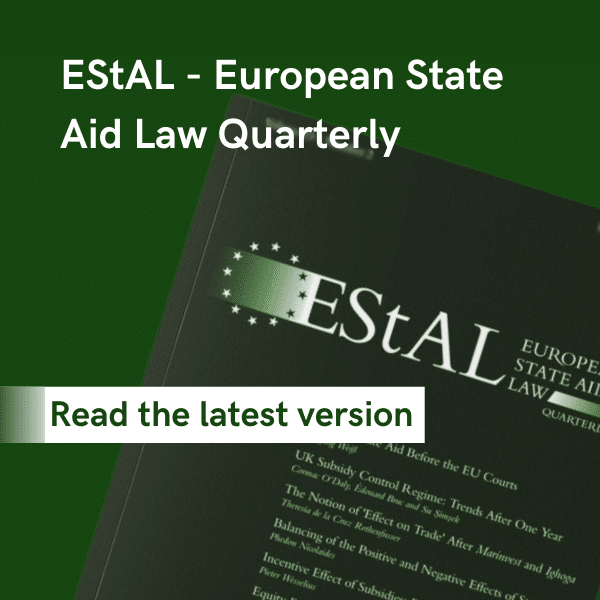
Introduction
Public funding that offsets costs incurred as a result of compliance with legal obligations constitutes State aid, if all of the criteria of Article 107(1) TFEU are satisfied. The fact that the purpose of the aid is to offset higher than otherwise costs is irrelevant.
However, Article 106(2) TFEU allows Member States to grant State aid to compensate for the extra costs of obligations imposed on undertakings but only when the undertakings provide services of general economic interest [SGEI] and only when the obligation results in loss of profit or revenue. Therefore, the calculation of the compensation hinges on a credible definition of what the SGEI provider in question would do in the absence of the obligation.
A case in point is a recent Commission decision authorising compensation granted to bpost, the main postal operator in Belgium. bpost is majority owned [51%] by the Belgian state. As a result of the complete liberalisation of the Belgian postal market, bpost holds no exclusive rights any more.
bpost operates under a “universal service obligation” [USO] to collect and distribute letters and parcels throughout the country. In addition, Belgian authorities also imposed on it the obligation to distribute newspapers and periodicals [press distribution].
So, in this case, bpost operates under two distinct obligations: for letters & parcels and for press distribution. The task for the Belgian authorities was to separate the costs linked press distribution from the USO-linked costs and also from the costs of other operations that bpost would have carried out in the absence of either of the two public service obligations. The Commission examined and approved the amount and method of calculation of the compensation in decision SA.105349 which was the latest of a number of similar measures all of which were approved by the Commission in the past.[1]
Service of general economic interest
Belgium has defined press distribution at home as an SGEI. As explained in the authorising Commission decision, “(28) the objective of this SGEI is to ensure a wide distribution of the written press throughout Belgium to enhance the level of information and diversity of opinion. In doing so, the Belgian State also wants to enhance public participation in the political debate.”
Belgium has also defined quality parameters for the press distribution. “(36) For newspapers: 1) 100% of the newspapers must have reached the newspaper subscriber’s home before 7:30 am on Mondays to Fridays and before 10:00 am on Saturdays. The distribution hours must be stable for each subscriber. Contractual sanctions and administrative sanctions are foreseen in case of non-compliance. 2) The SGEI provider must have at its disposal and under its control a network of (central, regional and local) warehouses where publishers deliver the newspapers at agreed times during the night in view to warrant the effective delivery to the subscribers on the next day. […] For periodicals: 1) 95% of all periodicals must be distributed at the subscriber’s home at Day+1 for weekly periodicals and at Day+2 for non-weekly periodicals; 97% of all periodicals must be distributed maximum one day later (thus, respectively, at Day+2 and Day+3). 2) The SGEI provider must have at its disposal and under its control a network of (central, regional and local) warehouses where publishers deliver big volumes of periodicals at agreed times at night in view of warranting the effective delivery to the subscribers within the above-mentioned deadlines. […]”
Formula for calculation of the public service compensation
The annual amount of the public service compensation granted to bpost ex ante was calculated according to the formula indicated in paragraph 64 of the Commission decision:
Cn/p = Fn/p + (Vn/p x Nn/p)
where,
Cn/p = Amount of the annual compensation for the press distribution (euro in year t).
Fn/p = Fixed amount for the press distribution, which is the same for every year of the entrustment and is equal to EUR […] million for the distribution of newspapers and EUR […] million for the distribution of periodicals.
Vn/p = Amount of compensation per newspaper/periodical distributed in conformity with the predetermined quality requirements during year t.
Nn/p = Number of newspapers/periodicals distributed in accordance with the quality requirements set out in the concession agreement.
As can be seen, the formula is made up of two components: a fixed and variable amount. Both “(67) amounts of compensation per newspaper/periodical were based on an ex-ante calculation of the cost that would be incurred by bpost in the provision of the SGEI, the tariffs to be paid by publishers for the distribution of newspapers/periodicals and on a forecast of the number of newspapers/periodicals that would be distributed during each year of the entrustment.”
“(68) The calculation of the cost of the provision of the SGEI was based on existing data. It included a mark-up of […] % to the total cost as reasonable profit.” However, the amount took into account the expected decrease in the volume of distributed printed material as a result of the increasing readership of digital publications and the fragmentation of the news sector [people obtaining their news from non-traditional sources].
The compensation would be paid ex post every month. That is, the annual amounts of compensation for newspapers and for periodicals were divided by 12. These amounts took into account also efficiency incentives.
Compensation cap
The Belgian authorities also defined a compensation cap so that the annual amounts of compensation would be subject to two ceilings applying to newspapers and periodicals, respectively. The ceilings were calculated using the net avoided cost [NAC] methodology. The actually paid compensation could not exceed those ceilings.
Moreover, the Belgian authorities checked for overcompensation on a 12-monthly basis. Any overcompensation had to be repaid immediately or transferred to the following year resulting in an equivalent reduction of compensation in that year.
Net avoided cost methodology
The calculation of the avoided cost of press distribution was based on the following assumptions concerning bpost:
“(100) (a) [It] would remain subject to its universal service obligations;
(b) take into account: the reaction of publishers to a variation in tariffs; the possibility for customers to transfer their demand to the commercial tariffs offered by bpost.”
The assumption concerning publishers meant that they could prefer to distribute their own publications resulting in less revenue for bpost. The assumption concerning customers to meant that they would increase demand for bpost services resulting in more revenue for bpost.
The cost accounting methodology of bpost
“(102-6) For its cost accounting, bpost uses an activity-based costing (ABC) methodology which allocates all operational costs, up to the level of earnings before interest and tax (EBIT), to its various products. The scope of the cost accounting includes all operating costs and all organisational units of bpost. The cost accounting methodology relates to three layers: resources, activities and products. The aim is to calculate the appropriate share of costs of each product. The costs of the resources are allocated to activities depending on their nature: “direct resources” are directly linked to a specific activity, while “indirect resources” contribute to several activities and need to be allocated using allocation keys that reflect the degree of usage of the resource by each activity. […] The different activities constitute the building blocks of the value chain of each product. The costs of operational activities (such as the sorting of letters) are allocated to products based on the extent to which the activity is used for each product. Costs of non-operational activities (such as the management and supervision in post offices) are allocated to the operational activities they contribute to, which are in turn allocated to products. At the last step of the procedure, the costs of the operational activities are finally allocated to each product in accordance with an allocation key, which is typically based on volume. All products that rely on an activity carry a share of the costs of that activity which is proportional to their volume of reliance on that activity.”
The building blocks of bpost’s cost acounting
| Level | Costs |
| 1 | Direct Resources [e.g. personnel, vehicles, etc] & Indirect Resources [e.g. administration, HR, public affairs, etc] |
| 2 | Operational Activities [e.g. collection & distribution, transportation, etc] |
| 3 | USO Products, SGEI Products, Competitive Products |
| 4 | Total cost & pricing |
Assessment of compatibility
The Commission assessed the compatibility of the compensation on the basis of the 2012 SGEI Framework. In what follows only the more unusual aspects of the compensation are reviewed.
With respect to compliance with public procurement procedures, the Commission agreed that the extension of bpost’s contract was in line with Article 43(1)(c) of Directive 2014/23, according to which “(i) the need for modification has been brought about by circumstances which a diligent contracting authority or contracting entity could not foresee; (ii) the modification does not alter the overall nature of the concession; (iii) […]”
The Belgian authorities argued that the war in Ukraine and the subsequent increase in energy and other prices necessitated the adjustment of the contract and the amounts of compensation.
With respect to the application of the NAC methodology for the calculation of the compensation, the Commission first examined the definition of the counterfactual scenario. Accordingly, it involved the following five steps described in paragraph 180 of the decision:
- Definition of a counterfactual scenario for the SGEI.
- Estimation of the impact of volume and price changes on the SGEI revenues.
- Estimation of the collateral impact on the revenues of other services.
- Estimation of the impact of volume, price and service changes and the changes in organisation and support activities on the SGEI costs.
- Estimation of the impact of volume, price and service changes and the changes in organisation and support activities on the costs of other services.
This approach ensured that no revenue or cost item was counted twice.
With respect to the definition of a credible counterfactual scenario, Belgium calulate the net cost of bpost operating without the newspapers and periodicals SGEIs. “(182) The Belgian authorities first determined the commercially optimal strategy that bpost would adopt for the delivery and pricing of newspapers and periodicals, should the SGEI constraints be lifted. In the counterfactual scenario, bpost would still be entrusted with the USO, under which there is currently no specific press offer in Belgium. Prices in the counterfactual are thus set in line with closest matching USO products.”
In the counterfactual scenario without an SGEI obligation for the delivery of newspapers and periodicals, delivery prices would increase, while demand and the frequency of deliveries would decrease.
With respect to efficiency incentives, Belgium, first, checks whether there is overcompensation. This would occur if the ex ante net cost exceeds the actual ex post net cost. Then, “(222) if, due to an efficient provision of the SGEI by bpost the net cost calculated ex post is lower than net cost calculated ex ante, bpost will keep 33% of the savings made and refund the remaining 67% to the Belgian authorities.”
As noted earlier, in order to prevent reduction of costs at the expense of quality, the SGEI definition also included minimum quality requirements.
Since the notified measure complied with all of the conditions in the 2012 SGEI Framework, the Commission approved the measure.
[1] The full text of the Commission decision can be accessed at:
https://ec.europa.eu/competition/state_aid/cases1/202519/SA_105349_82.pdf



